
|
Spinal Metastases |
|
The venous Batsonís plexus surrounding the spine is valveless. The venous system is named after Dr. Oscar Vivian Batson after his work in the early 40ís. Blood is able to flow in both directions, this represents an important step in the establishment of spinal metastases.
|
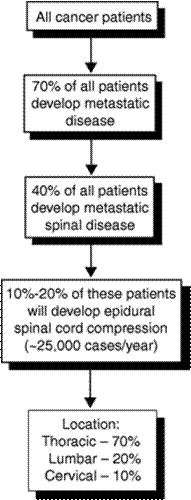
|
For patients who have symptomatic spinal metastases modern management consists of a multidisciplinary approach consisting of chemotherapy, radiotherapy, and surgery if indicated. |
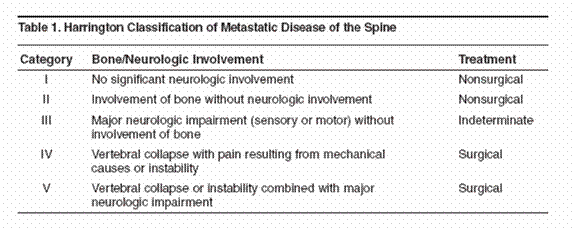
|
Tokuhashi (1990): |
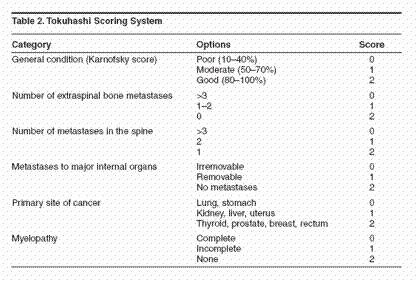
|
6† variables: general medical condition, number of extraspinal metastases, number of vertebral metastases, status of metastases to the major internal organs, primary tumor type, presence of a neurologic deficit
Scores < 5 generally die within 3 months not recommend for surgery Scores† > 9 survive an average of 12 months or more. recommend surgery Scores 5 Ė 9 no recommendation |
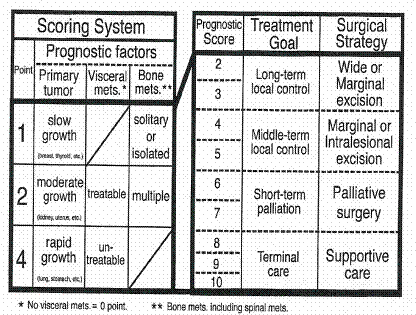
|
Tomita(2001) |
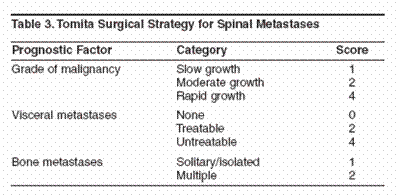
|
Decision Making Radiotherapy vs Surgery |

|
Vertebral Metastases - Literature Review |
|
In the past the surgical treatment for cord compression simply consisted of decompressive laminectomy. Retrospective review of these patients revealed little or no benefit especially if the initial complaints were of axial neck or back pain with or without symptoms of neurological compression. The aim is now for decompression with immediate stabilization of the affected segment(s). Note that all open surgical exposures are destabilizing, Choice of approach dependent on site of pathology in relation to cord and premorbid patient condition Post operatively the aim is to achieve IMMEDIATE stability, as the disease progresses, stability may be lost so stabilization methods should try to also anticipate short to medium concerns about disease progression and further instability. Altered biology of diseased bone (pathological) means that implants are preferred over structural bone grafts (auto or allograft) |
|
Harrington (1986): |
|
This has been modified to form part of the ASIA scoring system for spinal cord injury.
A: Complete sensory & motor loss B: Complete motor loss; incomplete sensory loss C: Some motor function below level of involvement; incomplete sensory loss D: Useful motor function below level of involvement; incomplete sensory loss E: Normal motor & sensory function |
|
Frankel (1969): |
|
Various classification systems are or have been used. Decision making may be guided by these.
Frankel 1969 Harrington JBJS(A) 1986 Tokuhashi et. al. Spine 1990 Tomita et. al. Spine 2001 |
|
Classification Systems |
|
Surgery: |
|
Multidisciplinary Approach: |
|
Surgical Decision Making: |
|
Surgery will not alter the natural progression of the disease, it will however hopefully lead to an improvement in the disease symptoms, especially when faced with symptoms of pain, instability and neurological deficit as a result of neural compression. Considerations for surgery include the type of carcinoma, the overall stage of the disease, the extent of the metastatic lesions, as well as the age and any other co-morbidities the patient may have. |
|
Breast (21%) Lung (14%) Prostate (7.5%) Renal (5%) GI (5%) Thyroid (2.5%) |
|
Common Sources: |
|
Spine is the most common site for skeletal metastases. Metastatic lesions are the most common tumors of the spine (98%). Vertebral body affected first, Batsonís Plexus Approximately 70% of patients who die of cancer have evidence of vertebral metastases on autopsy |
|
Harrington 1986: |
|
Batsonís Plexus: |
|
Copyright © 2008 Spine Care Hong Kong |


|
SPINE CARE HONG KONG |
|
ACCURATE DIAGNOSIS, STRUCTURED TREATMENT |
